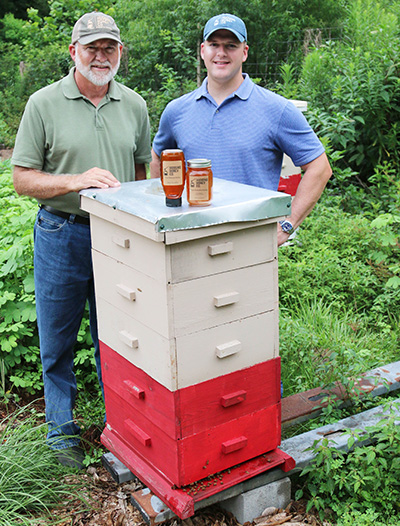Sweet Success: Beekeepers Buzz About Alabama Honey

Glenn Nall and Doug Hudgins have never met, but they’re united in a sweet appreciation for the golden, sticky goodness Alabama honeybees produce.
“It’s almost amazing to see honeybees work. It makes me thankful to have them,” said Nall, who lives in Castleberry in Conecuh County. “If I’m ever in a bad mood, I just go visit the hives and remember how simple life is.”
Nall, 80, has kept bees for over 55 years. He said he's an old-school beekeeper and doesn’t wear a beekeeper suit or veil when collecting honey. He lets Mother Nature lead bees to his hives, as opposed to purchasing from a breeder.
“Most of the hives I have now just swarmed in, and I was able to relocate them into a box where they started producing honey,” said Nall, whose 12 hives produce about 25 gallons of honey annually — enough to share with church family while saving some to swirl into dishes at home.
In Coosada, Hudgins and son Aaron divide and buy hives to expand their business in Elmore County. The duo began Hudgins Honey Co. in 2017 after years of hobby beekeeping. He said they intend to grow the 80-hive business to 200+ this year.
In 2017, their hives produced 60 gallons of raw honey.
The elder Hudgins said he never imagined his hobby could become a full-time job and business.
“We have people waiting to buy our honey,” said Doug, 57. “Sometimes it seems like it flies off the shelf.”
Doug handles day-to-day operations while Aaron markets and sells honey to local grocery stores and the Prattville Farm Center.
“Honey has health benefits most people don’t realize,” Hudgins said. “It can fix anything from allergies to the common cold.”
September is National Honey Month, a time to celebrate the sweet ingredient’s makers, said Alabama Bee & Honey Committee Chairman Lionel Evans.
“Bees pollinate 80 percent of crops,” said Evans, a Limestone County beekeeper. “Alabama farmers rely on the state’s agricultural insect — the queen honeybee — to pollinate crops like cotton, fruits and vegetables.”
Honey color and taste depend on the flower where the nectar is gathered, Nall said. Generally, lighter, milder honey is from privet, alfalfa and berries. Darker, more robust honey is flavored from mimosa trees and buckwheat.
Cotton nectar makes the sweetest honey, Hudgins said — although he and Nall agree their favorite honey is made, collected and enjoyed in their backyard.
“There is no better way to start the day than with hot pancakes with honey drizzled over the top and hot coffee that’s sweetened with a touch of honey,” Nall said.
For more information, visit Honey.com.
